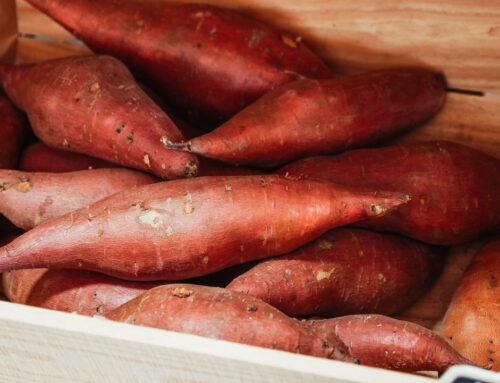Sweet potato weevil1)Credit of featured image by Author Graham Wise from Brisbane, Australia https://commons.wikimedia.org/wiki/File:Cylas_formicarius_(14576849194).jpg can be devastating in Africa. losses between 732)N.E.J.M.Smit,“The effect of the indigenous cultural practices of in-ground storage and piecemeal harvesting of sweetpotato on yield and quality losses caused by sweetpotato weevil in Uganda,” Agriculture, Ecosystems and Environment,vol.64,no. 3, pp. 191–200, 1997.-1003)K. O. Fuglie, “Priorities for sweetpotato research in developing countries: results of a survey,” HortScience,vol.42,no.5,pp. 1200–1206, 2007.4)J.Nderitu,M.Silai,G.Nyamasyo,andM.Kasina,“Insectspecies associated with sweet potatoes (Ipomoea batatas (L.) Lam) in Eastern Kenya,” International Journal of Sustainable Crop Production,vol.4,no.1,pp.14–18,2009% have been reported. The weevil damages crops in every life cycle. The most damage is through the female that lays eggs in the cracks of soil and exposed roots. The roots are covered with unsightly punctures that makes the tubers unmarketable. The larvae hatch in a week and feed, leaving a tunnel of destruction with excrement. The excrement, with terpene stench, makes it unmarketable and not fit for human and animal use5)I. C. Onwueme and W. B. Charles, “Tropical root and tuber crops: production, perspectives and future prospects,” FAO Plant Prod Prot Paper 126:129, Food and Agriculture Organi- zation of the United Nations, Rome, Italy, 1994.. Adults are good flyers so they spread easily to neighboring fields, starting new populations. Storage roots and runners are the most important spreading medium. With heavy infestations the vines turn yellow 6)I. Uritaini, T. Saito, H. Honda, and W. K. Kim, “Induction of furanoterpenoids in sweetpotato roots by the larval compo- nents of the sweetpotato weevils,” Agricultural and Biological Chemistry,vol.37,pp.1875–1862,1975., initially, then darkens, cracks, and collapses.
Sweet potato varieties do not have a significant resistance to the weevil, but it is found that kairomone concentrations on the root surface can act as an ovipositional stimulant for female weevils7)K.C.Son,R.F.Severson,R.F.Arrendale,andS.J.Kays,“Surface chemical differences between sweet potato lines with varying levels of resistance to the sweet potato weevil,” Journal of the American Society for Horticultural Science, vol. 115, no. 4, pp. 696–699, 1990.. So selecting varieties with higher kairomone concentration can lower damage8)R. K. Rao, “Systems approach for management of insect pest problemintubercropsbyfarmersofMeghalaya,”CTCRINews, vol. 22, pp. 3–4, 2005.. Varieties that have deep roots/tubers are also less susceptible to weevil damage9)Zimmerman, Thomas & Crossman, Stafford & Montilla, Carlos. (2014). Sweet Potato Weevil Damage Influenced by Variety and Harvest Date.. Treating the first 35cm of vines with Beauveria bassiana also helps to reduce weevil infestation. Removing crop residues from the field also helps against weevil infestation and propagation. Micro-climate does play a role in infestation levels. Through regular scouting every year and good record keeping, patterns can emerge when the weevil is most active and causes most damage. Minimum economic crop loss was found when sweet potatoes were planted during early November in Jamalpur10)Tipu, Mohammad & Jahan, Raunak & Rahman, Jubaidur & Rahman, Md & Islam, Md & Apu, Mosiur. (2021). Development of efficient integrated management package against sweet potato weevil (Cylas formicarius [Fabricius, 1798]). Acta agriculturae Slovenica. 117. 1. 10.14720/aas.2021.117.4.2066..
The most basic control measures are to keep infested material to the minimum. New transplants must not come in contact with old fields or planted as far as possible to old ones. Destroy all left over runners and tubers after harvest. Remove new sprouting tubers that are left over from the previous year. Ridging the tubers in the field will reduce the sweet potato weevil from reaching the storage roots to lay their eggs. A very easy way to reduce sweet potato weevil is to interplant with pepper, which is not only cost effective, but beneficial to the soil as well.11)Efurumibe, Priscilla & Asawalam, E. (2021). PEPPER-SWEET POTATO INTERCROP AS A COST-EFFECTIVE MANAGEMENT ALTERNATIVE AGAINST SWEET POTATO WEEVIL (Cylas puncticollis).
There are three active ingredients registered in South Africa:
- deltamethrin
- gamma-BHC
- triazophus
References
| ↑1 | Credit of featured image by Author Graham Wise from Brisbane, Australia https://commons.wikimedia.org/wiki/File:Cylas_formicarius_(14576849194).jpg |
|---|---|
| ↑2 | N.E.J.M.Smit,“The effect of the indigenous cultural practices of in-ground storage and piecemeal harvesting of sweetpotato on yield and quality losses caused by sweetpotato weevil in Uganda,” Agriculture, Ecosystems and Environment,vol.64,no. 3, pp. 191–200, 1997. |
| ↑3 | K. O. Fuglie, “Priorities for sweetpotato research in developing countries: results of a survey,” HortScience,vol.42,no.5,pp. 1200–1206, 2007. |
| ↑4 | J.Nderitu,M.Silai,G.Nyamasyo,andM.Kasina,“Insectspecies associated with sweet potatoes (Ipomoea batatas (L.) Lam) in Eastern Kenya,” International Journal of Sustainable Crop Production,vol.4,no.1,pp.14–18,2009 |
| ↑5 | I. C. Onwueme and W. B. Charles, “Tropical root and tuber crops: production, perspectives and future prospects,” FAO Plant Prod Prot Paper 126:129, Food and Agriculture Organi- zation of the United Nations, Rome, Italy, 1994. |
| ↑6 | I. Uritaini, T. Saito, H. Honda, and W. K. Kim, “Induction of furanoterpenoids in sweetpotato roots by the larval compo- nents of the sweetpotato weevils,” Agricultural and Biological Chemistry,vol.37,pp.1875–1862,1975. |
| ↑7 | K.C.Son,R.F.Severson,R.F.Arrendale,andS.J.Kays,“Surface chemical differences between sweet potato lines with varying levels of resistance to the sweet potato weevil,” Journal of the American Society for Horticultural Science, vol. 115, no. 4, pp. 696–699, 1990. |
| ↑8 | R. K. Rao, “Systems approach for management of insect pest problemintubercropsbyfarmersofMeghalaya,”CTCRINews, vol. 22, pp. 3–4, 2005. |
| ↑9 | Zimmerman, Thomas & Crossman, Stafford & Montilla, Carlos. (2014). Sweet Potato Weevil Damage Influenced by Variety and Harvest Date. |
| ↑10 | Tipu, Mohammad & Jahan, Raunak & Rahman, Jubaidur & Rahman, Md & Islam, Md & Apu, Mosiur. (2021). Development of efficient integrated management package against sweet potato weevil (Cylas formicarius [Fabricius, 1798]). Acta agriculturae Slovenica. 117. 1. 10.14720/aas.2021.117.4.2066. |
| ↑11 | Efurumibe, Priscilla & Asawalam, E. (2021). PEPPER-SWEET POTATO INTERCROP AS A COST-EFFECTIVE MANAGEMENT ALTERNATIVE AGAINST SWEET POTATO WEEVIL (Cylas puncticollis). |





Leave A Comment
You must be logged in to post a comment.